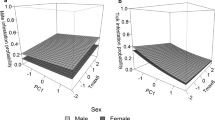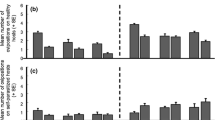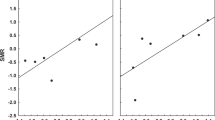Abstract
Parasites should make the same decisions that every animal makes regarding fitness reward. They can maximize reproductive success by selection of those habitats that guarantee the greatest fitness output. We consider the host population as a habitat of a parasite population. Consequently, hosts (=habitats) that differ quantitatively or qualitatively will support different numbers of parasites. The nature of habitat selection can be detected by isodars, lines along which habitat selection yields equivalent fitness reward. We applied this approach to study host selection of five fleas, each infesting two desert rodents. Xenopsylla conformis, Xenopsylla ramesis, Nosopsyllus iranus theodori and Stenoponia tripectinata medialis parasitize Gerbillus dasyurus and Meriones crassus. Synosternus cleopatrae pyramidis parasitizes Gerbillus andersoni allenbyi and Gerbillus pyramidum. Three fleas (X. conformis, X. ramesis and S. c. pyramidis) were able to perceive quantitative (amount of the resource; e.g. organic matter in the nest for flea larvae) and/or qualitative (pattern of resource acquisition; e.g. host defensiveness) differences between hosts. Two other fleas did not perceive between-host differences. X. conformis was a density-dependent host selector that showed sharp selectivity at low density. X. ramesis and S. c. pyramidis were density-independent host selectors with a direct correspondence of density with habitat quality. N. i. theodori and S. t. medialis were non-selectors with no relationship at all between density and host quality. The results of the application of the isodar theory suggest that ectoparasites, like other animals, behave as if they are able to make choices and decisions that favour environments in which their reproductive benefit is maximized.

Similar content being viewed by others
References
Abramsky Z, Rosenzweig ML, Subach A (1997) Gerbils under threat of owl predation: isoclines and isodars. Oikos 78:81–90
Bates JK (1961) Field studies on the behaviour of bird fleas. I. Behaviour of the adults of three species of bird fleas in the field. Parasitology 52:113–132
Croll NA, Anderson RM, Gyerkos TW, Ghardian E (1982) The population biology and control of Ascaris lumbricoides in a rural community in Iran. Trans R Soc Trop Med Hyg 76:187–197
Gallivan GJ, Horak IG (1997) Body size and habitat as determinants of tick infestations of wild ungulates in South Africa. S Afr J Wildl Res 27:63–70
Fernandez-Juricic E (2001) Density dependent habitat selection of corridors in a fragmented landscape. Ibis 143:278–287
Fretwell SD, Lucas HL (1970) On territorial behavior and other factors influencing habitat distribution in birds. I. Theoretical development. Acta Biotheor 19:16–36
Kelly DW, Thompson CE (2000) Epidemiology and optimal foraging: modeling the ideal free distribution of insect vectors. Parasitology 120:319–327
Khokhlova IS, Krasnov BR, Shenbrot GI, Degen A (2001) Body mass and environment: a study in Negev rodents. Isr J Zool 47:1–14
Kotler BP, Brown JS, Subach A (1993) Mechanisms of species coexistance of optimal foragers: temporal partitioning by two species of sand dune gerbils. Oikos 67:548–556
Krasnov BR, Khokhlova IS (2001) The effect of behavioural interactions on the exchange of flea (Siphonaptera) between two rodent species. J Vector Ecol 26:181–190
Krasnov BR, Shenbrot GI, Khokhlova IS, Ivanitskaya EI (1996a) Spatial structure of rodent community in the Ramon erosion cirque, Negev highlands (Israel). J Arid Environ 32: 319–327
Krasnov BR, Shenbrot GI, Khokhlova IS, Degen AA, Rogovin KA (1996b) On the biology of Sundevall's jird (Meriones crassus Sundevall) in Negev Highlands, Israel. Mammalia 60:375–391
Krasnov BR, Shenbrot GI, Medvedev SG, Vatschenok VS, Khokhlova IS (1997) Host-habitat relation as an important determinant of spatial distribution of flea assemblages (Siphonaptera) on rodents in the Negev Desert. Parasitology 114:159–173
Krasnov BR, Shenbrot GI, Medvedev SG, Khokhlova IS, Vatschenok VS (1998) Habitat-dependence of a parasite-host relationship: flea assemblages in two gerbil species of the Negev Desert. J Med Entomol 35:303–313
Krasnov BR, Hastriter M, Medvedev SG, Shenbrot GI, Khokhlova IS, Vaschenok VS (1999) Additional records of fleas (Siphonaptera) on wild rodents in the southern part of Israel. Isr J Zool 45:333–340.
Krasnov BR, Burdelova NV, Shenbrot GI, Khokhlova IS (2002a) Annual cycles of four flea species (Siphonaptera) in the central Negev desert. Med Vet Entomol 16:266–276
Krasnov BR, Khokhlova IS, Shenbrot GI (2002b) The effect of host density on ectoparasite distribution: an example with a desert rodent parasitized by fleas. Ecology 83:164–175
Krasnov BR, Khokhlova IS, Oguzoglu I, Burdelova NV (2002c) Host discrimination by two desert fleas using an odour cue. Anim Behav 64:33–40
Kuznetzov AA, Matrosov AN, Chyong LTV, Dat DT (1999) Movements of the synantropous rats and their fleas in the settlements of the southern Vietnam. Probl Osobo Opasnyh Infekt 79:59–65 (in Russian)
Legendre P, Legendre L (1998) Numerical ecology, 2nd English edn. Elsevier Science, Amsterdam
Lomnicki A (1988) Population ecology of individuals. Princeton University Press, Princeton, N.J.
Marshall AG (1981) The ecology of ectoparasite insects. Academic Press, London
Mooring MS, Benjamin JE, Harte CR, Herzog NB (2000) Testing the interspecific body size principle in ungulates: the smaller they come, the harder they groom. Anim Behav 60: 35–45
Morris DW (1987a) Ecological scale and habitat use. Ecology 68:362–369
Morris DW (1987b) Spatial scale and the cost of density-dependent habitat selection. Evol Ecol 1:379–388
Morris DW (1988) Habitat-dependent population regulation and community structure. Evol Ecol 2:253–269
Morris DW (1989) Density-dependent habitat selection: testing the theory with fitness data. Evol Ecol 3:80–94
Morris DW (1990) Temporal variation, habitat selection and community structure. Oikos 59:303–312
Morris DW (1994) Habitat matching: alternatives and implications to populations and communities. Evol Ecol 8:387–406
Morris DW (1996) Temporal and spatial population dynamics among patches connected by habitat selection. Oikos 75:207–219
Ovadia O, Abramsky Z (1995) Density-dependent habitat selection: evaluation of the isodar method. Oikos 73:86–94
Poulin R, Morand S (2000) The diversity of parasites. Quart Rev Biol 75:277–293
Prasad RS (1969) Influence of host on fecundity of the Indian rat flea, Xenopsylla cheopis (Roths.). J Med Entomol 6:443–447
Rodriguez MA (1995) Habitat-specific estimates of competition in stream salmonids — a field-test of the isodar model of habitat selection. Evol Ecol 9:169–184
Rosenzweig ML (1981) A theory of habitat selection. Ecology 62:327–335
Rosenzweig ML (1989) Habitat selection as a source of biological diversity. Evol Ecol 1:315–330
Rosenzweig ML (1991) Habitat selection and population interactions: the search of mechanism. Am Nat 137:5–28
Rosenzweig ML, Abramsky Z (1985) Detecting density-dependent habitat selection. Am Nat 126:405–417
Shenbrot GI, Krasnov BR (2000) Habitat selection along an environmental gradient: theoretical models with an example of Negev Desert rodents. Evol Ecol Res 2:257–277
Shenbrot GI, Krasnov BR, Khokhlova IS (1997) On the biology of Wagner's gerbil Gerbillus dasyurus (Wagner, 1842) (Rodentia: Gerbillidae) in the Negev Highlands, Israel. Mammalia 61:467–486
Shenbrot GI, Krasnov BR, Rogovin KA (1999) Spatial ecology of desert rodent communities. Springer, Berlin Heidelberg New York
Sokal RR, Rohlf FJ (1995) Biometry, 3rd edn. Freeman, New York
Sukhdeo MVK, Bansemir AD (1996) Critical resources that influence habitat selection decisions by gastrointestinal helminth parasites. Int J Parasitol 26:483–498
Sukhdeo MVK, Sukhdeo SC (1994) Optimal habitat selection by helminthes within the host environment. Parasitology 109:S41-S56
Sutherland WJ (1996) From individual behaviour to population ecology. Oxford University Press, Oxford
Theodor O, Costa M (1967) A survey of the parasites of wild mammals and birds in Israel. I. Ectoparasites. Israel Academy of Science and Humanities, Jerusalem
Traub R (1972) The relationship between the spines, combs and other skeletal features of fleas (Siphonaptera) and the vestiture, affinities and habits of their hosts. J Med Entomol 9:601
Tripet F, Richner H (1999) Density-dependent processes in the population dynamics of a bird ectoparasite Ceratophyllus gallinae. Ecology 80:1267–1277
Vatschenok VS (1988) Fleas — vectors of pathogens causing diseases in humans and animals. Nauka, Leningrad (in Russian)
Webber LA, Edman JD (1972) Anti-mosquito behaviour of ciconiiform birds. Anim Behav 20:228–232
Acknowledgements
We greatly appreciate the helpful comments and suggestions of Douglas Morris (Canada), Zvika Abramsky (Israel), and David Ward (South Africa) who read an earlier version of the manuscript. We thank two anonymous referees for their most helpful comments on the manuscript. This study was partly supported by the Israel Science Foundation (grant no. 663/01–1 to B. R. K., I. S. K. and G. I. S.). This is publication no. 140 of the Ramon Science Centre and no. 363 of the Mitrani Department of Desert Ecology.
Author information
Authors and Affiliations
Corresponding author
Rights and permissions
About this article
Cite this article
Krasnov, B.R., Khokhlova, I.S. & Shenbrot, G.I. Density-dependent host selection in ectoparasites: An application of isodar theory to fleas parasitizing rodents. Oecologia 134, 365–372 (2003). https://doi.org/10.1007/s00442-002-1122-2
Received:
Accepted:
Published:
Issue Date:
DOI: https://doi.org/10.1007/s00442-002-1122-2




